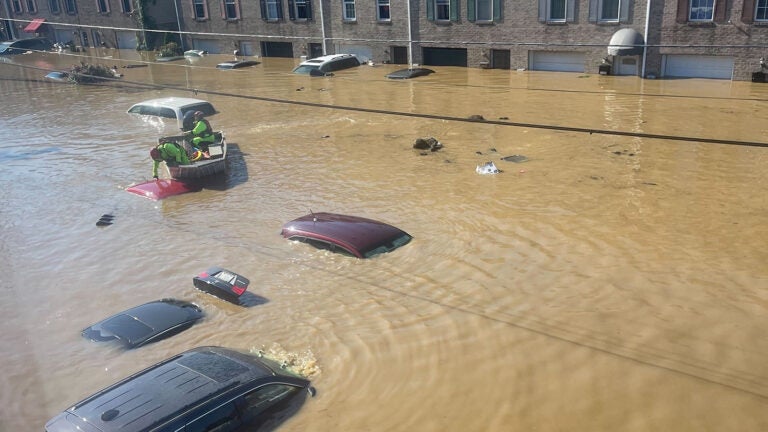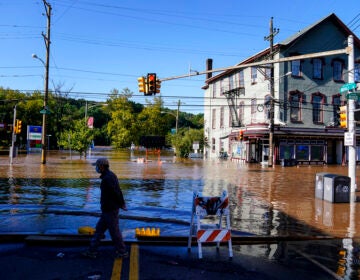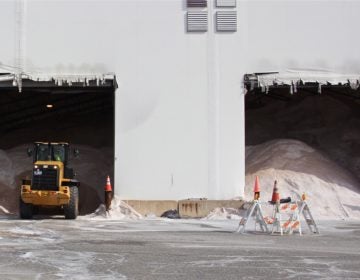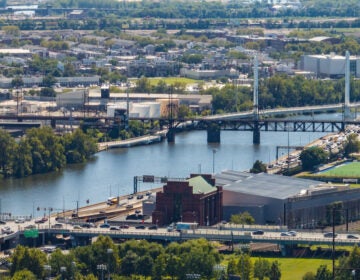More than 3 years after Hurricane Ida, study aims to prepare communities along the Brandywine for future storm
During the aftermath of Hurricane Ida, the Brandywine watershed was hit with the worst flooding in 200 years.
Listen 1:14
The flooding displaced hundreds of residents in Wilmington, and in Chester and Delaware counties — some of which have yet to return to their homes — and caused millions of dollars worth of property damage. (Courtesy Tamika Brooks Collick)
From Philly and the Pa. suburbs to South Jersey and Delaware, what would you like WHYY News to cover? Let us know!
On Sept. 2, 2021, Tamika Brooks Collick, her husband, and their two children sought refuge on the third floor of their Wilmington townhouse as they watched a rush of water creep up the stairs of their home — just two blocks from the Brandywine River.
Outside, the water flowing down the street had become so high that their parked car was almost submerged.
Brooks Collick and her family were experiencing the aftermath of Hurricane Ida, which caused the worst flooding in the Brandywine watershed in 200 years.
“I looked down at [my son] and I could just see his face, and I’ll never forget that. I said, ‘Daniel, we are okay,’ and he just burst out crying. I held him, and he was shaking,” she recalled of the traumatic incident. “As a mother, I was like, ‘Oh, my God, my child.’ I had him calm down. I just told him, ‘Don’t look outside.’”
Southeastern Pennsylvania and northern Delaware were hit hard, with waters reaching as high as two stories in Chadds Ford, Pennsylvania. The flooding displaced hundreds of residents in Wilmington, and in Chester and Delaware counties — some of which have yet to return to their homes — and caused millions of dollars worth of property damage.
The historic flooding event led the Brandywine Conservancy, the University of Delaware Water Resources Center and the Chester County Water Resources Authority to release a draft study this week, which aims to help communities along the Brandywine better prepare for future storms.
Among the recommendations outlined in the report include a number of infrastructure improvements, such as repairing or removing some dams, upgrading stormwater infrastructure and elevating homes along the Brandywine.
“We’re not going to solve flooding,” said Seung Ah Byun, executive director for the Chester County Water Resources Authority. “It’s going to happen, and it’s a matter of being prepared and making sure people are out of harm’s way as much as we can.”
Rain events in the region have become more intense as a result of climate change. Climate scientists expect the trend to continue, putting an increasing number of residences and businesses at risk for flooding. Currently, 5,000 residents live along the Brandywine’s floodplain.
Flooding in the upper reaches of the Brandywine watershed is exacerbated by the area’s sloping topography, creating a funnel-like shape in the watershed closer to the Pennsylvania-Delaware state line and generating more stormwater runoff in the area.
Though flood control facilities in the region can store more than 5 billion gallons of flood water, the study’s authors say it’s not enough to protect communities from major storms. So, they evaluated some of the factors that make the Brandywine vulnerable to flooding, and collected 1,500 comments from the public and stakeholders to help draft recommendations to reduce the impacts of storms.
The authors found 60% of the dams, culverts and bridges along the Brandywine exacerbate flooding because they are undersized or damaged. The report recommends further studies to determine whether some of these structures could be repaired, removed, or in some cases, modified to store higher volumes of flood waters.
Other infrastructure improvements outlined in the study include upgrading failing stormwater basins, and replacing impervious areas with vegetation to help prevent stormwater runoff.
The study recommends several other changes to protect people and property, including implementing additional restrictions on development in sloping areas, elevating homes and flood proofing businesses.
Municipalities could also improve their emergency response by communicating with the public about when and where to seek refuge, and by using floodgates to prevent people from driving down flooded roads, according to the study.
Brooks Collick, who runs a nonprofit that works to help homeowners impacted by Ida, said she hopes the study will encourage officials to work together to prevent flooding before the next major storm hits the region.
“The study has really helped us in the city of Wilmington so that we can look at how we are developing in and around the river, and helped us to work with our neighboring states and their organizations, because what happens up the river will impact what happens down the river,” she said.
One of the biggest hurdles to implementing the recommendations will be receiving federal funding, said Gerald Kauffman, one of the study authors and director of the University of Delaware’s Water Resource Center.
“We’re at a key watershed moment, as it were, where we have a lot of infrastructure flooding coming under the [Biden] administration, and the question is, ‘Will it be there in the [Trump] administration?’” he said. “But we know what the costs are. We know how to fix the problems. Will the money be there? Hopefully it will be for the good and welfare of the public that live in Wilmington and upstream.”
Following a 45-day public comment period, the organizations will publish a final report, at which time they will seek funding to implement the recommendations.

Get daily updates from WHYY News!
WHYY is your source for fact-based, in-depth journalism and information. As a nonprofit organization, we rely on financial support from readers like you. Please give today.







